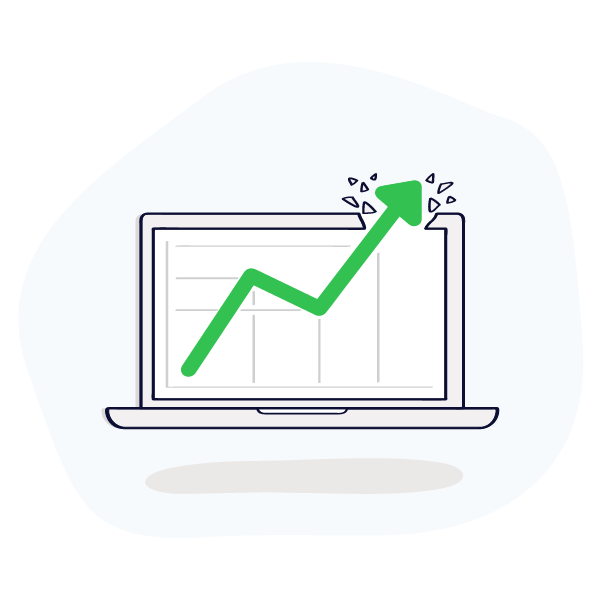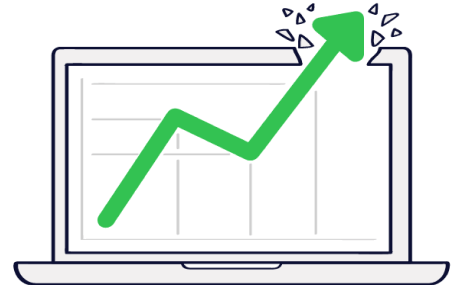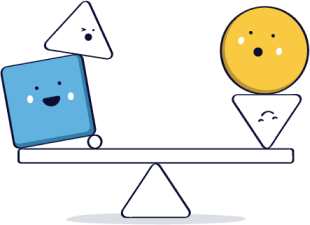Understanding CRM marketing

“Nutshell is super user-friendly and intuitive

“I would highly recommend Nutshell

“Easy to use and... wait for it ... 100% buy in!

“Nutshell is both simple and powerful
Although typically perceived as software for salespeople, CRMs are the secret sauce behind most successful marketing initiatives. Tapping into these CRM marketing techniques and learning how to use CRM for marketing will invariably elevate your sales team’s success.
CRM marketing is essential for business growth because it centralizes customer data, enabling B2B teams to deliver targeted, personalized campaigns that drive higher engagement, faster conversions, and stronger ROI. By aligning sales and marketing around shared insights, CRM systems eliminate silos and empower more strategic, scalable growth.



Take our guided tour to explore Nutshell’s incredible features!

Table of Contents
A CRM is an integral piece of software for marketers and salespeople. Powerful and versatile, you can use CRMs to manage every aspect of the sales pipeline, from signing up newsletter subscribers to nurturing longtime customers and literally everything in between. A finely-tuned CRM tracks and utilizes all the tiny pieces of data generated by prospects all the way from the tippy-top of the funnel until the moment they sign that sweet, sweet contract.
Since CRMs are all about capturing and organizing every piece of customer data, and marketing is all about turning that data into sales leads, CRMs and marketers are a perfect match. Furthermore, many marketers find themselves stuck in sales-heavy organizations, with fewer resources at their disposal than their sales colleagues.
We’ve got your back, marketers! This guide covers a few of the many ways marketers leverage CRMs, from side projects and growth hacks to core integral functions. Here, we’ll delve into why and how to use CRM for marketing and so much more.
CRM data is information collected from your customers, clients, website visitors, and leads. You store this data in a CRM platform for easy analysis and access. In other words, it’s first-party data you collect directly from your audience that you can use to personalize experiences on your website.
You can use various types of CRM data, such as:
CRM data helps you learn more about your audience to better understand their interests and how they interact with your company.
CRM marketing comprises the strategies and tactics employed by marketing teams powered by CRM data. With this approach, marketers take advantage of CRM technology to identify and analyze data that supports their marketing efforts. For example, customer names and email addresses collected from CRM data can be utilized for personalized email campaigns.
Using this data to its full potential brings sales and marketing teams together and builds more meaningful customer relationships and experiences. Done right, CRM marketing translates to more leads, more conversions, and more revenue.
There’s no doubt that a CRM data is a powerful resource that provides loads of valuable data to both sales and marketing teams. But how can this data benefit your business in the hands of your marketers?
With the best CRM for marketing and the correct data at your disposal, your marketing team can:
The fact is that CRM marketing is at the heart of the customer experience. Gathering, analyzing, and using CRM data effectively is part and parcel of customer experience management (CXM), a crucial aspect of every business’s marketing strategy.
With CRM data at their disposal, marketers can learn more about their customers and create a customer-centric approach. Deeper insight lets them monitor and encourage customer engagement tailored to the customer’s wants and needs.
The result is greater customer loyalty and retention and a marketing team with a real sense of who your audience is.
Now that we know more about CRM data and its role in CRM marketing let’s explore how marketers can use CRM software and CRM data from the top to the bottom of the funnel—and beyond.
Deploying a top-of-funnel CRM marketing strategy is all about generating awareness around your products, services, and brand. The idea is to get your prospects interested in your company and draw them into your sales funnel, converting them to leads.
With a great CRM on your side, marketers can create more effective top-of-funnel campaigns through various marketing channels and increase leads.
Newsletters are near the top of the marketing funnel. They typically contain company news, announcements, customer shoutouts, and recent blog content and are far from considered “selling material.” That said, they regularly keep your company’s brand in potential buyers’ minds, and CRMs play an integral role in newsletter distribution. Most CRMs will help you:
With a CRM or email marketing tool, you can distribute content to those who are interested and easily drop those who aren’t interested. Because CRMs are versatile, this activity can be completed by the marketing or sales team, depending on the organization’s structure.
Tailoring custom content to specific audiences is a phenomenal way to drive sales. A few list filters based on location, company size, and engagement can create a brand-new opportunity for email marketing. A CRM integrated with marketing automation software can automatically subscribe contacts to the most relevant lists throughout your sales funnel. These features are handy for marketers who want to promote specific offers and messages to particular audiences.
A CRM’s built-in metrics also help marketers identify who’s opening and engaging with your emails and who’s simply unreachable. Access to these reports makes it much easier to strategize which leads are worth resurrecting and which should be dropped off the map altogether.
Reporting on metrics (AKA results) is a key responsibility for any marketer. CRMs make this easier by providing built-in reporting on numerous data points. For instance, Nutshell offers reporting on sales performance and forecasting, team productivity, lead volume, conversions, lost leads, and just about everything else you could think of.

The key metrics that marketers use CRMs to track are:
Related reading: How to build a sales process: the complete guide.
When organizations send sales and marketing emails, they need to understand how each audience segment performs. A good marketer is always on top of their open rates, click-through rates, and subscriptions, and a good CRM allows them to be.
Most CRMs integrate with distribution services like Constant Contact and MailChimp. These allow marketers to easily segment their audiences and provide relevant messages to each one, depending on their place in the funnel.
By closely monitoring their engagement metrics, marketers and salespeople can quickly determine which campaigns are working and which adjustments and corrective actions to take. CRMs can also help identify which content, website landing pages, and direct mails aren’t doing well. With a properly configured CRM, marketers can see whether their prospect has engaged with any of their material or if they’re generally uninterested. If a prospect isn’t clicking anything, they might not be a solid lead. On the contrary, if a piece of marketing content isn’t getting clicked on by anyone, it’s time to either update it or eliminate it.
Marketers using landing page builders understand the importance of tracking from source to sale. Someone might sign up for a newsletter, read it once, and then never interact with your company. On the contrary, the same newsletter might generate a lead that turns into a sale and leaves you wondering why.
To shed some light on these mystery conversions, marketers can integrate their landing page publisher with a CRM and track the lead from source to sale. At Nutshell, we simplify things further with our native Landing pages feature. This add-on is just one of the many marketing tools accessible from the Nutshell dashboard.
Data captured from landing pages and web forms will automatically populate the CRM with the data needed, allowing marketers to track their leads as they progress through the pipelines. Leads that progress all the way from the landing page and convert into a sale can indicate that the landing page itself is healthy since it provides the CRM with quality leads. If there’s a landing page that never generates any sales, it can indicate that the landing page, or the sales processes associated with that pipeline, needs some work.
Tracking the effectiveness of landing pages and web forms and the quality of their leads allows marketers to make budgetary decisions related to their advertising and marketing channels. Based on which channels send the most leads and which leads produce the most sales, it becomes easier to decide which sources to cut and which to improve.
Did you know your CRM can help you analyze how your prospects and current customers interact with your brand on social media?
Integrating your CRM with your social media platforms allows you to implement and manage sales-boosting campaigns.
For example, you can:
Use this data to focus on the platforms your audience is active on to expand your brand awareness and reach. You can also leverage your data to create more content and posts that resonate with your audience’s interests to increase engagement.
To maximize your sales from your ad campaign, you need to ensure your ads reach your ideal customers. That’s where your CRM data can help.
As we discussed above, CRM marketing leverages what you learn about your current customers, clients, and prospects. Your CRM can provide information about their:
With this information, you can ensure your ads reach the people who are most likely to purchase your products or services.
For example, advertising channels, such as social media and over-the-top (OTT) video streaming platforms like YouTube and Hulu, let you select audience targeting features for your ad campaigns.
Simply choose the CRM marketing channels that match the makeup of your current customers or clients and watch your sales and revenue soar.
These CRM marketing examples use data to initiate campaigns aimed at leads in the middle of your sales funnel. According to your CRM data, these prospects know about you and have shown some interest in your products or services.
Clearly defined sales pipelines are the foundation of an effective sales team. CRMs allow marketers to send targeted messages to people depending on their stage in the pipeline. You can customize sales pipelines to reflect different products and buyer journeys, meaning that marketers can use completely different strategies on entirely different people. (See also: multiple pipelines in Nutshell Pro)
Leads can enter your pipeline from various sources and channels. These include demo requesters, referrals, form submissions, and direct callers. But they vary from business to business and product to product, and it’s a marketer’s job to deliver the right messages to all these leads. This way, there is little chance you’ll bombard a customer looking for business cards and signage with messages about web page builders.
For instance, if someone signs up for a company’s webinar, your CRM should be configured so that they:
Salespeople and marketers alike rely heavily on a CRM’s conversation-tracking capabilities. Most CRMs have this functionality built in and on display in an easy-to-find location. With Nutshell, logged activities, calls, emails, stage changes, new leads, new companies, and new people are grouped into a common feed called a timeline.
With your activities and messages aggregated in one common place, it’s easy for marketers to:
When sourcing marketing content, the timeline is a fantastic place to start. An up-to-date timeline will contain tons of customer data, including who’s using your products and to what extent. Depending on the customers ‘ interactions with your team, browsing customer interactions may reveal potential customer success stories, testimonials, or quotes.
Content is an essential part of any fully-formed marketing strategy. It’s responsible for a significant portion of organic website traffic and propels people through the sales pipeline. Content is a marketer’s greatest tool for grabbing the attention of potential customers and steering them in the right direction. A bit of content about product comparisons might be the perfect tool to turn an unengaged shopper into a buyer. Sending a thank-you email with bonus tips can transform a new customer into a power user.
Since content plays a strategic role, staying on top of the metrics is crucial. Obvious metrics can include the basics like the number of content offer downloads, the number of clicks, and the time spent on the page. Strategically, marketers also look beyond those to gauge which demographics respond to specific content types, what role timing plays in content engagement, and which points in the sales process require more content. A concise marketing strategy in an accurate CRM is a flexible and invaluable method of getting the right content to the right users.
Simply put, when a user signs up for your content, they trust you that you’ll refrain from spamming or bombarding them but give them more of what they asked for instead. Use this opportunity to make their experience even better.
Webinars are an up-and-coming trend in the sales and marketing world. A reported 95% of marketers cite webinars as an essential component in achieving their marketing objectives.
Webinars are a common form of content marketing, existing solely to provide valuable information in exchange for email addresses and other contact information, usually collected upon registration. Tracking attendees in a CRM is excellent for marketers because it clarifies the attendees’ place in the sales pipeline and provides clues into the types of education they seek.
Webinar content typically includes helpful information, tips and tricks, and industry trends. It usually won’t include an explicit sales pitch—that’s what demos are for. Webinar attendees are higher in the funnel and aren’t ready to hear why they must act fast and buy now. They’re there to learn and absorb the webinar’s content, which means webinars should be about something seriously thoughtful and more than just another stop in the buyers’ journey.
Incentivizing your prospects (and customers) to engage with your brand is always a good idea. This model varies across the board depending on the industry and the products sold. But, the basic idea is that businesses provide customers with points, cash back, and other rewards in exchange for repeat business and referrals. It’s a win-win!
When implemented correctly, incentives can translate to extremely lucrative referrals when implemented correctly. For example, Sephora’s Beauty Insider rewards program has more than 17 million members that comprise as much as 80% of Sephora’s annual sales. The program is partly successful due to its flexibility: Members earn points with every purchase and can redeem them for any Sephora product they’d like.
Dropbox implemented a simple referral program for its users. Users could earn 500MB of free space with minimal effort by referring friends with just a signup URL. Due to its simplicity, this program was wildly successful and earned them 4 million new users in just 15 months.
You can enhance this marketing strategy by using a CRM, which allows marketers to easily subscribe rewards club members to relevant content. This keeps members continually engaged with the program, even if they hardly see the website or other communication channels. By keeping their rewards content fresh and getting it in front of interested customers, marketers can keep their engagement numbers healthy and their customers happy.
When leads reach the bottom of the sales funnel, it means they’re close to converting, and it’s time to convince them to choose you. Marketing campaigns targeting bottom-of-funnel leads include sales-oriented messaging that’s specific and tailored to the prospect.
When configured properly, CRMs capture tons of useful data about customers and prospects. By the bottom of the funnel, they’ve already been added to a pipeline that matches their demographic information. These leads have engaged with content, progressed through your sales process thanks to your sales team’s efforts, and expressed interest in a product. Now it’s time to sell.
At this point, you can leverage more information about the person and company to make the offer more targeted and relevant. Marketers often accomplish this by creating sales, promotions, and offers that appeal to people close to the end of the sales pipeline.
“In honor of Research Week, we are offering 25% off the list price for all Research Admins and Assistants.”
Deals like this serve as a means to accelerate people through the pipeline and reopen conversations with people who are close to making a purchasing decision but have gone cold for whatever reason.
Some CRMs, like Nutshell, offer location-based marketing features that show where prospects are distributed, allowing salespeople and marketers to make informed decisions.
For instance, if a company wants to open a new store in a specific city. Marketers would create several maps for the neighboring areas with various offers and promotions. With proper pipeline and list management, they could examine which marketing efforts generate the most traffic and continuously improve their strategies.
Marketers take location-based marketing tactics to the next level by advertising to people as they hit specific locations, like walking by their store or getting close to a competitor’s store. Using beacon technology, marketers can even advertise to customers inside the store, promoting deals that may appeal to their demographic.
Location-based marketing also provides marketers with a head start toward their market segmentation initiatives. Customer location is the most basic form of segmentation, and marketers who use their CRMs for location-based strategies can update their pipelines accordingly, ensuring all prospect records remain accurate.
Try Nutshell free for 14 days or let us show you around before you dive in.

Another example of CRM in marketing is when marketers use CRM data to inform other aspects of the marketing process, including administrative activities. These elements play an important supporting role in your overall CRM marketing strategy and can make or break campaigns if ignored.
Market segmentation involves separating people, companies, and leads into groups based on their similarities or, more specifically, their propensity to respond similarly to specific marketing tactics. Although there’s a lot of work to do offscreen, the end result means that marketers can sift entities into various pipelines in the hopes of maximizing their marketing impact.
Marketers typically distribute their prospects into categories based on the following types of segmentation:
By properly segmenting audiences within their CRM, marketers can easily increase their conversion rates between pipeline stages and waste less time on less fruitful tactics. It’s all about getting the right message to the right people—and CRMs help marketers do it better.
This section is just a summary—check out our comprehensive market segmentation guide for more.
Backlinks are on every marketer’s radar. For everyone outside the marketing world, a backlink is a hyperlink from one site back to yours. They’re crucial because there is strategic value in acquiring backlinks from certain sites, mainly ones with similar content (and keywords) and a high domain authority. When these sites link to your site, it drives more organic traffic and boosts your page’s SEO. Moz describes them as “a ‘vote of confidence’ from one site to another.” Backlinks from spam sites or other sites with very poor domain authority have the opposite effect, hurting your domain’s authority and reputation by association.
Unfortunately, requesting and obtaining a backlink from a targeted website is hardly ever straightforward. It usually goes something like this:
After performing this exercise a few times, marketers will discover it creates inbox clutter, with long email threads and multiple contacts for each company. This is where a CRM makes a huge difference.
By managing backlink negotiation with a CRM, marketers can keep track of everything in one place and perform on-the-spot analyses of their efforts. Is there a “buddy” company that’s always happy to link to relevant articles? Do your prospects always ask about your domain authority? Is your email getting responses? Answering questions like these can boost your success rate and secure more links to your site.
Author’s note: I created a special pipeline in Nutshell for my personal efforts, securing and nurturing backlink leads.
By using a CRM to manage backlinks and also disavowing the toxic ones, we boosted the domain authority of this very site and saw a quick 11% increase in organic traffic.
As a vital CRM marketing channel, your website needs to provide an attention-grabbing and positive user experience to drive conversions and sales for your business. The first-party data in your CRM is key to giving your prospects all the information they need to convert.
As we discussed above, your CRM data helps you learn about your audience’s interests and which pages they interact with on your website. You can use these insights to personalize your prospects’ experiences on your site.
Suppose you sell sporting equipment. You can implement dynamic content on your site’s homepage that displays a custom welcome message for your visitors based on their interests.
For example, if one of your prospects is interested in hiking, your message could read, “Welcome, hiker.” You can go a step further and provide a direct link to your hiking products.
Personalizing your website keeps your prospects engaged and informs your audience that your business offers the products or services they want.
In summary, the core CRM marketing examples show how CRM data drives targeted strategies, boosts engagement and strengthens relationships. By leveraging CRM data effectively, marketers can optimize every stage of the sales funnel.
Every business wants to grow and improve its revenue. Investing in a solid CRM and employing the right people to manage the data can have a massive impact on your business’s success.
Regardless of your industry, your audience has options, and it’s your job to stand head and shoulders above your competitors to win those leads and conversions.
The best way to do this is to provide leads and customers with a unique experience tailored to their needs. You want to make your customers feel like you understand them and have explicitly designed your products and services for them.
The detailed customer data gathered through your CRM makes this unique customer experience possible. Your CRM data should give you all the insight you need to nurture leads and conversions, giving you more revenue and helping you grow your business.
You’ll need more than just CRM software and captured customer information to integrate the data with your marketing efforts. To ensure you develop CRM marketing strategies and tactics that work, your team must manage the CRM data correctly.
Proper data management begins with understanding that your CRM software is more than just a data storage system. To create customer-centric marketing campaigns, you’ll need to ensure your data sets are connected and organized for easy access and analysis.
Your data should also be free from incomplete, inconsistent, and duplicate data. Cleaning your data thoroughly using data scrubbing software is a great way to ensure it’s ready for distribution or transformation, depending on your needs.
Without appropriate management and organization, data can fall through the cracks, making it difficult to track customer behavior accurately.
With accurate and well-organized CRM data at hand, you can improve the customer support and satisfaction experience in the following ways:
When customers experience seamless support delivered by a team with the correct information who understand their particular needs, customers are satisfied and more inclined to be loyal to your brand.
Artificial intelligence is transforming how we live and do business, and its impact on the CRM marketing landscape has already been significant. We have AI CRM features to thank for enhanced customer engagement, personalization, productivity, and more.
Some of the key areas you’ll see AI implementation in CRM marketing include:
As you can see, when implemented sensibly, the impact of AI in CRM on marketing can be far-reaching. But what are the eventual benefits of these incredible features?
Some of the most important benefits of AI in CRM marketing include:
Perhaps you’re looking for CRM software and tools for your small business or as a solopreneur. Or maybe you need an enterprise-level solution for a corporation. No matter the size of your business, Nutshell provides CRM software with all the tools you need to integrate your customer data with your marketing strategy—hassle-free.
Nutshell is an easy-to-use CRM that makes pipeline management and workflow automation a breeze. And with it, you’ll have access to world-class CRM marketing and engagement tools.
Our marketing software makes the most of your customer data, allowing you to generate and nurture leads and prospects through different marketing channels:
Leverage Nutshell’s Engagement Suite to include Web chat and Nutshell SMS in your marketing engagement toolkit:
You can even integrate Nutshell with your social media accounts, existing email marketing apps, and more. It’s the perfect way to streamline all your marketing communications.
Segment and target audiences from your contacts, send them visually impactful emails, and track audience engagement all from within the app.
Nutshell simplifies and improves your marketing goals and tasks by helping you extract, analyze, organize, and use your customer data to your advantage.
Check out this video to learn more about Email marketing:
There are many more ways for marketers to use CRM. The master plan involves gathering as much data as possible and using it to refine the sales process from the top of the funnel all the way to the bottom. A CRM is a goldmine of prospect information waiting for savvy marketers to transform it into something beautiful.
Want to learn more about how to use your CRM data to level up your marketing game? Download our handy B2B Marketer’s Toolkit, packed with expert tips on CRM marketing, lead generation, SEO, PPC ads, and plenty more.
Table of Contents

Join 30,000+ other sales and marketing professionals. Subscribe to our Sell to Win newsletter!
 Email & Calendar Sync
Email & Calendar Sync
Use our calculator to add up your total investment of CRM and Add-ons
VIEW ALL PRICING
 Product Info
Product Info Education & Guides
Education & Guides Company
Company